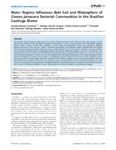Please use this identifier to cite or link to this item:
http://www.alice.cnptia.embrapa.br/alice/handle/doc/974585Full metadata record
| DC Field | Value | Language |
|---|---|---|
| dc.contributor.author | KAVAMURA, V. N. | pt_BR |
| dc.contributor.author | TAKETANI, R. G. | pt_BR |
| dc.contributor.author | LANÇONI, M. D. | pt_BR |
| dc.contributor.author | ANDREOTE, F. D. | pt_BR |
| dc.contributor.author | MENDES, R. | pt_BR |
| dc.contributor.author | MELO, I. S. de | pt_BR |
| dc.date.accessioned | 2013-12-20T11:11:11Z | pt_BR |
| dc.date.available | 2013-12-20T11:11:11Z | pt_BR |
| dc.date.created | 2013-12-20 | pt_BR |
| dc.date.issued | 2013 | pt_BR |
| dc.identifier.citation | Plos One, San Francisco, v. 8, n. 9, e73606, 2013. | pt_BR |
| dc.identifier.uri | http://www.alice.cnptia.embrapa.br/alice/handle/doc/974585 | pt_BR |
| dc.description | Abstract: We used the T-RFLP technique combined with Ion Torrent (PGM) sequencing of 16S rRNA and multivariate analysis to study the structure of bulk soil and rhizosphere bacterial communities of a cactus, Cereus jamacaru, from the Brazilian Caatinga biome, which is unique to Brazil. The availability of water shapes the rhizosphere communities, resulting in different patterns during the rainy and dry seasons. Taxonomic approaches and statistical analysis revealed that the phylum Actinobacteria strongly correlated with the dry season, while samples from the rainy season exhibited a strong correlation with the phylum Proteobacteria for rhizosphere samples and with the phyla Bacteroidetes, Firmicutes, Lentisphaerae, and Tenericutes for bulk soil samples. The STAMP software also indicated that the phylum Bacteroidetes, as well as two classes in the Proteobacteria phylum (c and d), were the most significant ones during the rainy season. The average abundance of the phylum Actinobacteria and the genus Bacillus was significantly greater during the dry season. Some significant genera found during the dry season might reflect their tolerance to the extreme conditions found in the Caatinga biome. They may also indicate the ecological function that microorganisms play in providing plants with some degree of tolerance to water stress or in assisting in their development through mechanisms of growth promotion. Alterations in microbial communities can be due to the different abilities of native microorganisms to resist and adapt to environmental changes. | pt_BR |
| dc.language.iso | eng | eng |
| dc.rights | openAccess | eng |
| dc.title | Water regime influences bulk soil and rhizosphere of Cereus jamacaru bacterial communities in the Brazilian caatinga biome. | pt_BR |
| dc.type | Artigo de periódico | pt_BR |
| dc.date.updated | 2014-02-11T11:11:11Z | pt_BR |
| dc.subject.thesagro | Rizosfera | pt_BR |
| dc.subject.thesagro | Caatinga | pt_BR |
| riaa.ainfo.id | 974585 | pt_BR |
| riaa.ainfo.lastupdate | 2014-02-11 | pt_BR |
| dc.contributor.institution | VANESSA NESSNER KAVAMURA, ESALQ-USP; RODRIGO GOUVEA TAKETANI; MILENA DUARTE LANÇONI, ESALQ-USP; FERNANDO DINI ANDREOTE, ESALQ-USP; RODRIGO MENDES, CNPMA; ITAMAR SOARES DE MELO, CNPMA. | pt_BR |
| Appears in Collections: | Artigo em periódico indexado (CNPMA)  | |
Files in This Item:
| File | Description | Size | Format | |
|---|---|---|---|---|
| 2013AP39.pdf | 2.07 MB | Adobe PDF |  View/Open |









